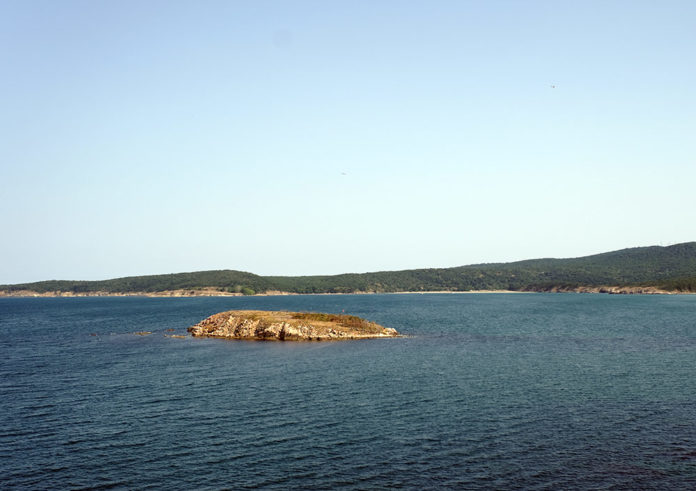Quick facts (at a glance)
- Where: Arkutino Bay, Southern Bulgarian Black Sea coast, 7 km north of Primorsko and ~15 km south of Sozopol. Part of the Ropotamo Nature Reserve.
- Size: ~0.012 km² (≈ 3 acres).
- Names: St. Toma / St. Thomas Island (остров св. Тома), “Snake Island” (Змийски остров).
- Signature sight: A blanket of prickly‑pear cacti (Opuntia)—non‑native plants that now dominate much of the island.
- Status: Strictly protected (landing generally not allowed).
Where is St. Toma Island?
St. Toma sits a few hundred meters offshore in Arkutino Bay, within Bulgaria’s Burgas Province. It lies between two beloved seaside bases: Primorsko to the south and Sozopol to the north. Administratively and ecologically, it falls inside the Ropotamo Nature Reserve, one of the coast’s most biodiverse protected areas.
Why the nickname “Snake Island”?
The island’s waters and sun‑warmed rocks host grey water snakes, commonly known as dice snakes—fish‑eating, non‑venomous reptiles that are a hallmark of this shoreline. You’ll often spot them swimming near the estuary beaches or basking on rock ledges. They are protected wildlife, so admire them from a distance.
The cactus island of the Black Sea
One of the most surreal sights on Bulgaria’s coast is the mass of prickly‑pear cacti (genus Opuntia) that carpet much of St. Toma. The story goes back to 1933, when Tsar Boris III instructed royal botanist Ivan Buresh to plant Opuntia pads—reportedly sourced via the Botanical Garden in Bratislava—as an acclimatization experiment. The cacti thrived and now form dense, thorny thickets across the rock. (Opuntia is native to the Americas, which makes this thriving Black Sea colony all the more unusual.)
A 3,000‑year timeline in 300 words
For a rock you can circumnavigate in minutes by boat, St. Toma is loaded with history:
- Early Iron Age Thracians: Archaeologists have found evidence of ritual pits and a sunken coastal fortress in the shallow waters between the island and the mainland—signs of a busy ancient shoreline. archaeologyinbulgaria.com
- Early Byzantines (5th–6th c.): Traces of settlement point to a strategic outpost controlling the sea route between Apollonia Pontica (Sozopol) and Constantinople.
- Medieval period (12th–14th c.): Ruins of a small monastery on the island crown echo its later Christian phase. The modern name, St. Thomas, comes from a chapel that once stood here.
Together, these finds suggest St. Toma served as a way‑station and shrine on one of antiquity’s most important Black Sea corridors.
Nature snapshot: flora & fauna
- Flora: Besides the headlining Opuntia, the island supports salt‑tolerant grasses and shrubs adapted to wind, spray, and shallow soils. On the mainland margins of the reserve you’ll find freshwater and brackish habitats (notably Arkutino marsh) famed for white and yellow water lilies.
- Fauna: Dice snakes are the icon here, but Ropotamo as a whole hosts rich birdlife and raptors over its cliffs and river bends. Historically, the Mediterranean monk seal occurred along Bulgaria’s Black Sea but is now extinct in the country—a sobering reminder of how fragile coastal ecosystems can be.
Can you visit St. Toma Island?
Landing on St. Toma is not permitted under the rules of the Ropotamo Nature Reserve. The reserve allows organized boat trips on the Ropotamo River and visits only on designated routes; ad hoc landings, camping, or collecting are prohibited. The best way to see the island is from the shore (Arkutino Beach) or by a licensed boat that cruises past the island without stopping. Always follow local guidance—the protection status is strict for good reason.
How to see it (responsibly)
- Best viewpoints: Walk the Arkutino dune‑backed beach or the low bluffs around Humata Foreland for photo‑worthy angles of the island’s cactus‑crowned profile.
- Boat perspective: Combine a Ropotamo River boat trip with a coastal cruise that passes Arkutino Bay. It’s the safest and most respectful way to scan the rocks for snakes and seabirds.
- Leave no trace: You’re in a strict reserve—stick to marked paths on the mainland, keep drones grounded unless expressly permitted, and never disturb wildlife.
Nearby attractions (easy half‑day add‑ons)
- Ropotamo Nature Reserve – Slow riverboat rides through longoz forest, lily‑fringed backwaters, and rock formations like Lion’s Head. Family‑friendly and photogenic.
- Beglik Tash (Thracian sanctuary) – An open‑air megalithic complex near Primorsko. Think “Bulgaria’s Stonehenge”: ritual stones, a “sun clock,” and a short woodland approach.
- Sozopol Old Town (Apollonia Pontica) – Cobbled lanes, 19th‑century wooden houses, and an ancient pedigree; archaeologists still probe its Greek and Roman layers.
- Arkutino Marsh & Dunes – A mosaic of dunes and wetlands known for water lilies and coastal birds, right behind the beach facing St. Toma.
- Castle “In Love with the Wind” (Ravadinovo) – A fairytale‑style castle with gardens and lakes—a fun detour if you’re traveling with kids.
Practical tips
- Base yourself in Sozopol or Primorsko for the best mix of beaches, boats, and culture.
- Respect closures: If a path or beach section is seasonally restricted for wildlife, choose another viewpoint.
- Wildlife etiquette: Snakes here are non‑venomous but protected—no handling, no feeding, no flashes inches from their faces.
FAQ
Is it safe?
Yes—dice snakes are non‑venomous. Keep a respectful distance, and everyone wins.
Can I land on the island?
No. St. Toma is within a strict nature reserve; landing typically requires a scientific or management permit. Enjoy it from approved paths and boat routes.
When do the cacti look their best?
Summer brings the most vivid Opuntia pads and flowers; you’ll see the green “cactus blanket” from shore all season. (Opuntia are New World natives that adapt well in warm, sunny niches.)



